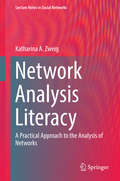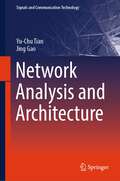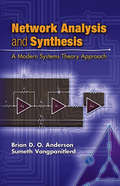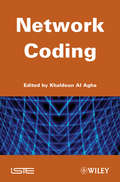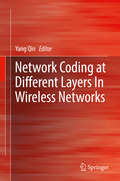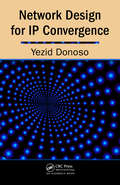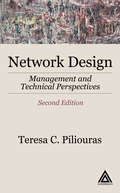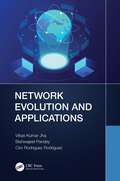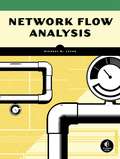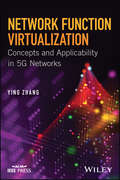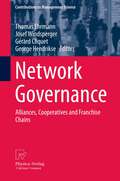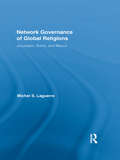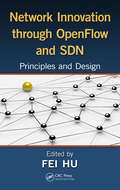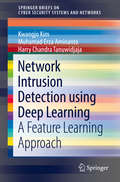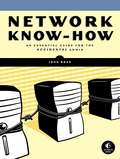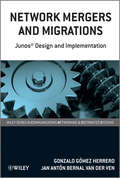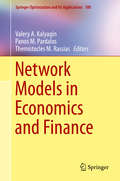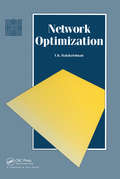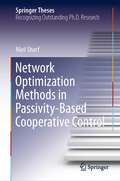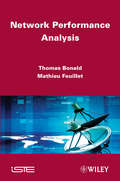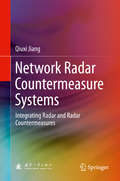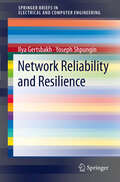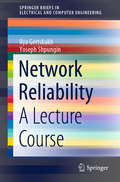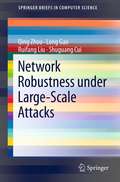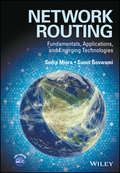- Table View
- List View
Network Analysis Literacy
by Katharina A. ZweigThis book presents a perspective of network analysis as a tool to find and quantify significant structures in the interaction patterns between different types of entities. Moreover, network analysis provides the basic means to relate these structures to properties of the entities. It has proven itself to be useful for the analysis of biological and social networks, but also for networks describing complex systems in economy, psychology, geography, and various other fields. Today, network analysis packages in the open-source platform R and other open-source software projects enable scientists from all fields to quickly apply network analytic methods to their data sets. Altogether, these applications offer such a wealth of network analytic methods that it can be overwhelming for someone just entering this field. This book provides a road map through this jungle of network analytic methods, offers advice on how to pick the best method for a given network analytic project, and how to avoid common pitfalls. It introduces the methods which are most often used to analyze complex networks, e. g. , different global network measures, types of random graph models, centrality indices, and networks motifs. In addition to introducing these methods, the central focus is on network analysis literacy - the competence to decide when to use which of these methods for which type of question. Furthermore, the book intends to increase the reader's competence to read original literature on network analysis by providing a glossary and intensive translation of formal notation and mathematical symbols in everyday speech. Different aspects of network analysis literacy - understanding formal definitions, programming tasks, or the analysis of structural measures and their interpretation - are deepened in various exercises with provided solutions. This text is an excellent, if not the best starting point for all scientists who want to harness the power of network analysis for their field of expertise.
Network Analysis and Architecture (Signals and Communication Technology)
by Jing Gao Yu-Chu TianThis book covers network analysis and architecture for large-scale computer network planning. Networks and the Internet are essential for modern industries and societies. Building a new network, upgrading an existing network, or planning to use a public network requires integrating various network mechanisms and technologies in a cohesive fashion. This demands a deep understanding of the concepts, principles, processes, approaches, and good practices of advanced network planning. More specifically, emphasizing service-based networking, the book introduces structured processes for network planning, provides systematic approaches for network analysis and architecture, develops network planning specifications, and discusses high-level network architectural models from various perspectives. It also offers detailed discussions on component-based architecture about addressing, routing, performance, management, and security and privacy. Recent developments in data centers, virtualization, and cloud are also embedded into the network architecture. Moreover, the book includes a comprehensive introduction to building practical TCP/IP network communications via sockets with practical examples. The book is suitable for use as a textbook for senior undergraduate and postgraduate students or as a reference book for network practitioners looking to develop or enhance their skills in network planning.
Network Analysis and Synthesis: A Modern Systems Theory Approach (Dover Books on Engineering)
by Brian D. Anderson Sumeth VongpanitlerdGeared toward upper-level undergraduates and graduate students, this book offers a comprehensive look at linear network analysis and synthesis. It explores state-space synthesis as well as analysis, employing modern systems theory to unite the classical concepts of network theory. The authors stress passive networks but include material on active networks. They avoid topology in dealing with analysis problems and discuss computational techniques. The concepts of controllability, observability, and degree are emphasized in reviewing the state-variable description of linear systems. Explorations of positive real and bounded real functions and matrices include their applications to optimal control, filtering, and stability.Excellent illustrations highlight this text, which represents the definitive tool for integrating an understanding of network theory with related fields such as control theory and communication systems theory.
Network Coding
by Khaldoun Al AghaNetwork coding, a relatively new area of research, has evolved from the theoretical level to become a tool used to optimize the performance of communication networks – wired, cellular, ad hoc, etc. The idea consists of mixing “packets” of data together when routing them from source to destination. Since network coding increases the network performance, it becomes a tool to enhance the existing protocols and algorithms in a network or for applications such as peer-to-peer and TCP. This book delivers an understanding of network coding and provides a set of studies showing the improvements in security, capacity and performance of fixed and mobile networks. This is increasingly topical as industry is increasingly becoming more reliant upon and applying network coding in multiple applications. Many cases where network coding is used in routing, physical layer, security, flooding, error correction, optimization and relaying are given – all of which are key areas of interest. Network Coding is the ideal resource for university students studying coding, and researchers and practitioners in sectors of all industries where digital communication and its application needs to be correctly understood and implemented. Contents 1. Network Coding: From Theory to Practice, Youghourta Benfattoum, Steven Martin and Khaldoun Al Agha. 2. Fountain Codes and Network Coding for WSNs, Anya Apavatjrut, Claire Goursaud, Katia Jaffrès-Runser and Jean-Marie Gorce. 3. Switched Code for Ad Hoc Networks: Optimizing the Diffusion by Using Network Coding, Nour Kadi and Khaldoun Al Agha. 4. Security by Network Coding, Katia Jaffrès-Runser and Cédric Lauradoux. 5. Security for Network Coding, Marine Minier, Yuanyuan Zhang and Wassim Znaïdi. 6. Random Network Coding and Matroids, Maximilien Gadouleau. 7. Joint Network-Channel Coding for the Semi-Orthogonal MARC: Theoretical Bounds and Practical Design, Atoosa Hatefi, Antoine O. Berthet and Raphael Visoz. 8. Robust Network Coding, Lana Iwaza, Marco Di Renzo and Michel Kieffer. 9. Flow Models and Optimization for Network Coding, Eric Gourdin and Jeremiah Edwards.
Network Coding at Different Layers in Wireless Networks
by Yang QinThis book focuses on how to apply network coding at different layers in wireless networks - including MAC, routing, and TCP - with special focus on cognitive radio networks. It discusses how to select parameters in network coding (e. g. , coding field, number of packets involved, redundant information ration) in order to be suitable for the varying wireless environments. The author explores how to deploy network coding in MAC to improve network performance and examine joint network coding with opportunistic routing to improve the successful rate of routing. In regards to TCP and network coding, the author considers transport layer protocol working with network coding to overcome the transmission error rate, particularly with how to use the ACK feedback of TCP to enhance the efficiency of network coding. The book pertains to researchers and postgraduate students, especially whose interests are in opportunistic routing and TCP in cognitive radio networks.
Network Design for IP Convergence
by Yezid DonosoThe emergence of quality-of-service (QoS) mechanisms continues to propel the development of real-time multimedia services such as VoIP and videoconferencing. However, many challenges remain in achieving optimized standardization convergence. Network Design for IP Convergence is a comprehensive, global guide to recent advances in IP network implementation. Providing an introduction to basic LAN/WAN/MAN network design, the author covers the latest equipment and architecture, addressing, QoS policies, and integration of services, among other topics. The book explains how to integrate the different layers of reference models and various technological platforms to mirror the harmonization that occurs in the real world of carrier networks. It furnishes appropriate designs for traditional and critical services in the LAN and carrier networks (both MAN and WAN), and it clarifies how a specific layer or technology can cause those services to malfunction. This book lays a foundation for understanding with concepts and applicability of QoS parameters under the multilayer scheme, and a solid explanation of service infrastructure. It goes on to describe integration in both real time and "not real time," elaborating on how both processes can co-exist within the same IP network and concluding with the designs and configurations of service connections.Learn How to Overcome Obstacles to Improve TechnologyThis sweeping analysis of the implementation of IP convergence and QoS mechanisms helps designers and operators get past key obstacles, such as integrating platform layers and technologies and implementing various associated QoS concepts, to improve technology and standards.
Network Design: Management and Technical Perspectives
by Teresa C. PiliourasThere are hundreds of technologies and protocols used in telecommunications. They run the full gamut from application level to physical level. It is overwhelming to try to keep track of them. Network Design, Second Edition: Management and Technical Perspectives is a broad survey of the major technologies and networking protocols and how they interr
Network Evolution and Applications
by Vikas Kumar Jha Bishwajeet Kumar Pandey Ciro RodriguezNetwork Evolution and Applications provides a comprehensive, integrative, and easy approach to understanding the technologies, concepts, and milestones in the history of networking. It provides an overview of different aspects involved in the networking arena that includes the core technologies that are essential for communication and important in our day-to-day life. It throws some light on certain past networking concepts and technologies that have been revolutionary in the history of science and technology and have been highly impactful. It expands on various concepts like Artificial Intelligence, Software Defined Networking, Cloud Computing, and Internet of Things, which are very popular at present. This book focuses on the evolutions made in the world of networking. One can’t imagine the world without the Internet today; with the Internet and the present- day networking, distance doesn’t matter at all. The COVID-19 pandemic has resulted in a tough time worldwide, with global lockdown, locked homes, empty streets, stores without consumers, and offices with no or fewer staff. Thanks to the modern digital networks, the culture of work from home (WFH) or working remotely with the network/Internet connection has come to the fore, with even school and university classes going online. Although WFH is not new, the COVID-19 pandemic has given it a new look, and industries are now willfully exploring WFH to extend it in the future. The aim of this book is to present the timeline of networking to show the developments made and the milestones that were achieved due to these developments.
Network Flow Analysis (No Starch Press Ser.)
by Michael W. LucasYou know that servers have log files and performance measuring tools and that traditional network devices have LEDs that blink when a port does something. You may have tools that tell you how busy an interface is, but mostly a network device is a black box. Network Flow Analysis opens that black box, demonstrating how to use industry-standard software and your existing hardware to assess, analyze, and debug your network.Unlike packet sniffers that require you to reproduce network problems in order to analyze them, flow analysis lets you turn back time as you analyze your network. You'll learn how to use open source software to build a flow-based network awareness system and how to use network analysis and auditing to address problems and improve network reliability. You'll also learn how to use a flow analysis system; collect flow records; view, filter, and report flows; present flow records graphically; and use flow records to proactively improve your network. Network Flow Analysis will show you how to:–Identify network, server, router, and firewall problems before they become critical–Find defective and misconfigured software–Quickly find virus-spewing machines, even if they’re on a different continent–Determine whether your problem stems from the network or a server–Automatically graph the most useful dataAnd much more. Stop asking your users to reproduce problems. Network Flow Analysis gives you the tools and real-world examples you need to effectively analyze your network flow data. Now you can determine what the network problem is long before your customers report it, and you can make that silly phone stop ringing.
Network Function Virtualization: Concepts And Applicability In 5g Networks (Wiley - Ieee Ser.)
by Ying ZhangA horizontal view of newly emerged technologies in the field of network function virtualization (NFV), introducing the open source implementation efforts that bring NFV from design to reality This book explores the newly emerged technique of network function virtualization (NFV) through use cases, architecture, and challenges, as well as standardization and open source implementations. It is the first systematic source of information about cloud technologies' usage in the cellular network, covering the interplay of different technologies, the discussion of different design choices, and its impact on our future cellular network. Network Function Virtualization: Concepts and Applicability in 5G Networks reviews new technologies that enable NFV, such as Software Defined Networks (SDN), network virtualization, and cloud computing. It also provides an in-depth investigation of the most advanced open source initiatives in this area, including OPNFV, Openstack, and Opendaylight. Finally, this book goes beyond literature review and industry survey by describing advanced research topics such as service chaining, VNF orchestrations, and network verification of NFV systems. In addition, this resource: Introduces network function virtualization (NFV) from both industrial and academic perspectives Describes NFV's usage in mobile core networks, which is the essence of 5G implementation Offers readers a deep dive on NFV's enabling techniques such as SDN, virtualization, and cloud computing Network Function Virtualization: Concepts and Applicability in 5G Networks is an ideal book for researchers and university students who want to keep up with the ever-changing world of network function virtualization.
Network Governance
by Gérard Cliquet George Hendrikse Josef Windsperger Thomas EhrmannThe current book on Nework Governance contributes to the literature by offering new perspectives on network goals and performance, inter-organizational learning and trust in alliances, corporate governance issues in cooperatives, governance of cross-border retail networks, contract design and governance innovations in cooperatives and fanchising.
Network Governance of Global Religions: Jerusalem, Rome, and Mecca (Routledge Research in Information Technology and Society)
by Michel S. LaguerreThis study seeks to explain three models of network governance embedded in digital practices that the mainstream monotheistic religions—Judaism, Catholic Christianity, and Islam—have used to lead and manage the worldwide distribution of their local nodes, exploring the connection between network governance and its digital embeddedness and showing how the latter enhances the performance of the former.
Network Innovation through OpenFlow and SDN: Principles and Design
by Fei HuThis book explains how to use software-defined networking (SDN) technologies powered by the OpenFlow protocol to build networks that are easy to design, less expensive to build and operate, and more agile and customizable. Among the first books to systematically address the design aspects in SDN/OpenFlow, it presents the insights of expert contributors from around the world. Focused on OpenFlow engineering design and basic principles, it includes coverage of system architectures, language and programming issues, switches, multimedia support, and network operating systems.
Network Intrusion Detection using Deep Learning: A Feature Learning Approach (SpringerBriefs on Cyber Security Systems and Networks)
by Kwangjo Kim Muhamad Erza Aminanto Harry Chandra TanuwidjajaThis book presents recent advances in intrusion detection systems (IDSs) using state-of-the-art deep learning methods. It also provides a systematic overview of classical machine learning and the latest developments in deep learning. In particular, it discusses deep learning applications in IDSs in different classes: generative, discriminative, and adversarial networks. Moreover, it compares various deep learning-based IDSs based on benchmarking datasets. The book also proposes two novel feature learning models: deep feature extraction and selection (D-FES) and fully unsupervised IDS. Further challenges and research directions are presented at the end of the book. Offering a comprehensive overview of deep learning-based IDS, the book is a valuable reerence resource for undergraduate and graduate students, as well as researchers and practitioners interested in deep learning and intrusion detection. Further, the comparison of various deep-learning applications helps readers gain a basic understanding of machine learning, and inspires applications in IDS and other related areas in cybersecurity.
Network Know-How: An Essential Guide for the Accidental Admin
by John RossAre the machines in your office living isolated lives? Do you have a few computers at home that you want to connect to each other and the Internet? The best way to share files on a group of computers is to create a network. But how do you do that?Network Know-How is your guide to connecting your machines, filled with practical advice that will show you how to get things done. You'll learn the nitty-gritty of network setup, design, and maintenance, from running cables and placing wireless access points to configuring file sharing and printing. This practical and comprehensive guide will teach you how to implement security, create intranets, and more. You'll learn how to:–Connect Windows, Macintosh, and Linux computers–Implement network addressing–Configure your network adapters, hubs, switches, and router–Share music, photos, and documents–Automate household appliances and stream digital audio and video to your home entertainment center–Troubleshoot network slowdowns and failuresNo matter which operating system you use, and even if you’ve never installed or run a network before, you’ll get what you need to know in Network Know-How.
Network Mergers and Migrations
by Jan Ant?n Bernal van der Ven Gonzalo G?mez HerreroThis book provides you with guidelines to plan, design, roll out, and accomplish network migration activities with a variety of internetworking case studies. It considers both enterprise and service provider scenarios based on the expertise from Juniper Networks engineers. From Metro Ethernet migration approaches to comprehensive network protocol consolidation and integration, each case study covers JUNOS resources to ensure successful completion at each migration phase. In addition to an appendix of automation scripts and examples and guidelines for each step, the book also describes the modern challenges that evolve in IT networks.
Network Models in Economics and Finance
by Panos M. Pardalos Valery A. Kalyagin Themistocles M. RassiasUsing network models to investigate the interconnectivity in modern economic systems allows researchers to better understand and explain some economic phenomena. This volume presents contributions by known experts and active researchers in economic and financial network modeling. Readers are provided with an understanding of the latest advances in network analysis as applied to economics, finance, corporate governance, and investments. Moreover, recent advances in market network analysis that focus on influential techniques for market graph analysis are also examined. Young researchers will find this volume particularly useful in facilitating their introduction to this new and fascinating field. Professionals in economics, financial management, various technologies, and network analysis, will find the network models presented in this book beneficial in analyzing the interconnectivity in modern economic systems.
Network Optimization
by V. BalakrishnanProblems in network optimization arise in all areas of technology and industrial management. The topic of network flows has applications in diverse fields such as chemistry, engineering, management science, scheduling and transportation, to name a few. Network Optimization introduces the subject to undergraduate and graduate students in computer science, mathematics and operations research. The focus is mainly on developing the mathematical underpinnings of the techniques that make it possible to solve the several optimization problems covered in the text. The text discusses such topics as optimal branching problems, transshipment problems, shortest path problems, minimum cost flow problems, maximum flow problems, matching in bipartite and nonbipartite graphs and many applications to combinatorics. Also included is a large number of exercises.
Network Optimization Methods in Passivity-Based Cooperative Control (Springer Theses)
by Miel SharfThis book establishes an important mathematical connection between cooperative control problems and network optimization problems. It shows that many cooperative control problems can in fact be understood, under certain passivity assumptions, using a pair of static network optimization problems. Merging notions from passivity theory and network optimization, it describes a novel network optimization approach that can be applied to the synthesis of controllers for diffusively-coupled networks of passive (or passivity-short) dynamical systems. It also introduces a data-based, model-free approach for the synthesis of network controllers for multi-agent systems with passivity-short agents. Further, the book describes a method for monitoring link faults in multi-agent systems using passivity theory and graph connectivity. It reports on some practical case studies describing the effectivity of the developed approaches in vehicle networks. All in all, this book offers an extensive source of information and novel methods in the emerging field of multi-agent cooperative control, paving the way to future developments of autonomous systems for various application domains
Network Performance Analysis (Wiley-iste Ser.)
by Thomas Bonald Mathieu FeuilletThe book presents some key mathematical tools for the performance analysis of communication networks and computer systems. Communication networks and computer systems have become extremely complex. The statistical resource sharing induced by the random behavior of users and the underlying protocols and algorithms may affect Quality of Service. This book introduces the main results of queuing theory that are useful for analyzing the performance of these systems. These mathematical tools are key to the development of robust dimensioning rules and engineering methods. A number of examples illustrate their practical interest.
Network Radar Countermeasure Systems
by Qiuxi JiangThis is the very first book to present the network radar countermeasure system. It explains in detail the systematic concept of combining radar and radar countermeasures from the perspective of the information acquisition of target location, the optimization of the reconnaissance and detection, the integrated attack of the signals and facilities, and technological and legal developments concerning the networked system. It achieves the integration of the initiative and passivity, detection and jamming. The book explains how the system locates targets, completes target identification, tracks targets and compiles the data.
Network Reliability and Resilience
by Ilya Gertsbakh Yoseph ShpunginThis book is devoted to the probabilistic description of the behavior of a network in the process of random removal of its components (links, nodes) appearing as a result of technical failures, natural disasters or intentional attacks. It is focused on a practical approach to network reliability and resilience evaluation, based on applications of Monte Carlo methodology to numerical approximation of network combinatorial invariants, including so-called multidimensional destruction spectra. This allows to develop a probabilistic follow-up analysis of the network in the process of its gradual destruction, to identify most important network components and to develop efficient heuristic algorithms for network optimal design. Our methodology works with satisfactory accuracy and efficiency for most applications of reliability theory to real -life problems in networks.
Network Reliability: A Lecture Course (SpringerBriefs in Electrical and Computer Engineering)
by Ilya Gertsbakh Yoseph ShpunginThis introductory book equips the reader to apply the core concepts and methods of network reliability analysis to real-life problems. It explains the modeling and critical analysis of systems and probabilistic networks, and requires only a minimal background in probability theory and computer programming. Based on the lecture notes of eight courses taught by the authors, the book is also self-contained, with no theory needed beyond the lectures. The primary focus is on essential “modus operandi,” which are illustrated in numerous examples and presented separately from the more difficult theoretical material.
Network Robustness under Large-Scale Attacks
by Ruifang Liu Shuguang Cui Qing Zhou Long GaoNetwork Robustness under Large-Scale Attacks provides the analysis of network robustness under attacks, with a focus on large-scale correlated physical attacks. The book begins with a thorough overview of the latest research and techniques to analyze the network responses to different types of attacks over various network topologies and connection models. It then introduces a new large-scale physical attack model coined as area attack, under which a new network robustness measure is introduced and applied to study the network responses. With this book, readers will learn the necessary tools to evaluate how a complex network responds to random and possibly correlated attacks.
Network Routing: Fundamentals, Applications, and Emerging Technologies
by Sudip Misra Sumit GoswamiNetwork Routing: Fundamentals, Applications and Emerging Technologies serves as single point of reference for both advanced undergraduate and graduate students studying network routing, covering both the fundamental and more moderately advanced concepts of routing in traditional data networks such as the Internet, and emerging routing concepts currently being researched and developed, such as cellular networks, wireless ad hoc networks, sensor networks, and low power networks.
